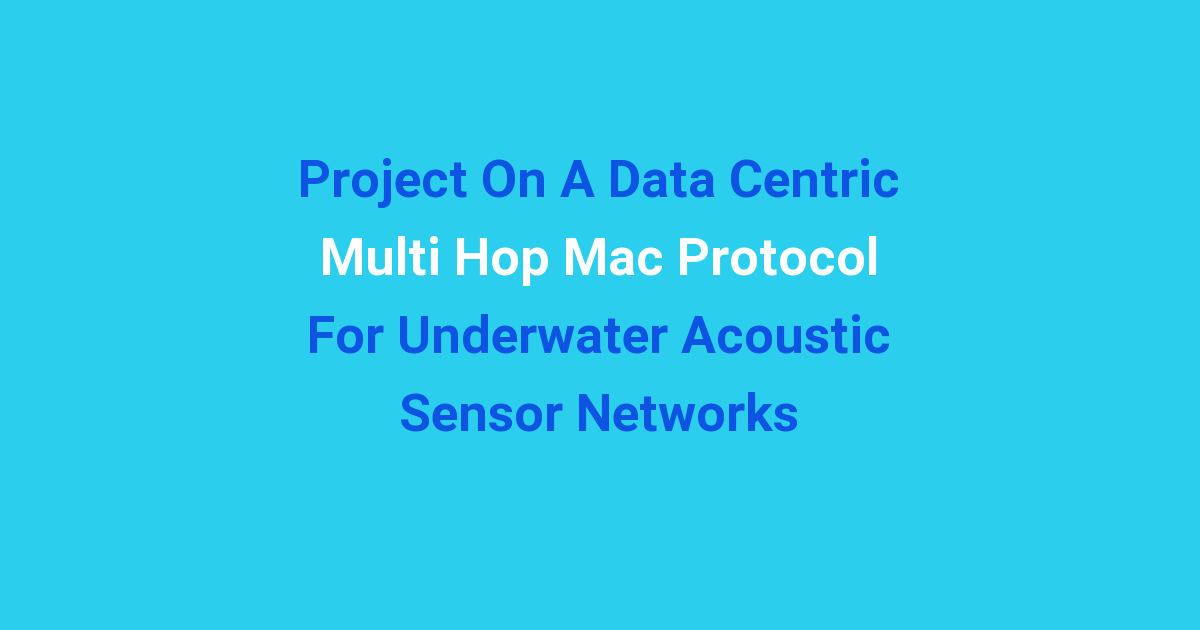Researching a data-centric multi-hop MAC protocol designed specifically for use in underwater acoustic sensor networks.
Project on Data Centric Multi Hop MAC Protocol for Underwater Acoustic Sensor Networks
Introduction
Underwater Acoustic Sensor Networks (UASN) are an emerging technology that has gained significant research attention in recent years. These networks are used for various applications such as environmental monitoring, underwater navigation, and offshore oil exploration. One of the key challenges in UASN is designing efficient Medium Access Control (MAC) protocols that can handle the unique characteristics of underwater acoustic communication.
In this project, we aim to design a data-centric multi-hop MAC protocol for UASN that can improve the network performance in terms of energy efficiency, data delivery ratio, and latency.
Problem Statement
The existing MAC protocols for UASN are mainly based on single-hop communication, where data packets are directly transmitted to the sink node. This approach may lead to inefficient use of resources, as data packets have to travel long distances through the water medium, which is characterized by high propagation delays and limited bandwidth.
Moreover, traditional MAC protocols do not utilize the multi-hop communication capabilities of underwater sensor nodes, which can help in extending the network coverage and reducing energy consumption.
Existing System
One of the commonly used MAC protocols in UASN is the Time Division Multiple Access (TDMA), which divides the communication time into slots and assigns each node a specific time slot for data transmission. However, TDMA may not be suitable for multi-hop communication scenarios, as it requires the synchronization of nodes, which is challenging in underwater environments.
Another MAC protocol is the Carrier Sense Multiple Access (CSMA), where nodes listen to the medium before transmitting data. However, CSMA may lead to high collision rates in UASN due to the long propagation delays and limited bandwidth.
Disadvantages of Existing System
The main disadvantages of the existing MAC protocols for UASN include:
- Low energy efficiency
- Low data delivery ratio
- High latency
- Lack of support for multi-hop communication
These limitations restrict the scalability and reliability of underwater acoustic sensor networks, especially in large-scale deployments.
Proposed System
In this project, we propose a data-centric multi-hop MAC protocol for UASN that addresses the shortcomings of the existing systems. The key features of our proposed protocol include:
- Support for multi-hop communication
- Energy-efficient data aggregation and forwarding
- Dynamic slot allocation based on network traffic
- Adaptive modulation and coding schemes
Our protocol aims to improve the network performance in terms of energy efficiency, data delivery ratio, and latency, while ensuring reliable communication in underwater environments.
Advantages of Proposed System
The advantages of our proposed data-centric multi-hop MAC protocol for UASN include:
- Improved energy efficiency through optimized data aggregation
- Enhanced data delivery ratio by utilizing multi-hop communication
- Reduced latency through dynamic slot allocation
- Increased network coverage and scalability
By incorporating these features, our protocol can overcome the limitations of the existing MAC protocols and provide a more reliable and efficient communication solution for underwater acoustic sensor networks.
Features of Proposed System
Our proposed data-centric multi-hop MAC protocol for UASN offers the following key features:
- Support for multi-hop communication: Nodes can relay data packets to reach the sink node, extending the network coverage.
- Energy-efficient data aggregation: Nodes can aggregate data packets before forwarding, reducing the energy consumption.
- Dynamic slot allocation: Time slots are dynamically allocated based on the network traffic, optimizing the communication efficiency.
- Adaptive modulation and coding: Nodes can adjust the modulation and coding schemes based on channel conditions, improving the data delivery ratio.
These features make our protocol suitable for underwater acoustic sensor networks, enabling efficient and reliable communication in challenging underwater environments.
Conclusion
In conclusion, our project on designing a data-centric multi-hop MAC protocol for UASN aims to address the limitations of the existing MAC protocols and provide a more efficient and reliable solution for underwater acoustic sensor networks. By supporting multi-hop communication, energy-efficient data aggregation, dynamic slot allocation, and adaptive modulation and coding, our protocol can improve the network performance in terms of energy efficiency, data delivery ratio, and latency. With further development and testing, our proposed system has the potential to enhance the scalability and reliability of UASN, opening up new possibilities for underwater applications in various fields.

